大纲:
1、逻辑判断
2、if流程控制语句
3、for循环控制语句
----------------------------------------------
在开始之前,先了解一下逻辑判断符号:
&& 与、|| 或、! 非
A && B 必须A,B同时成立,才能通过判断
---> 判断流程:先执行A判断其是否成立,若成立,则继续执行B,判断其是否成立
---> 若不成立,则直接结束,不再执行B
A || B A、B有一个成立,即可通过判断
!A 若A不成立,则通过判断
----------------------------------------------
----------------------------------------------
在条件判断时,那面会比较数值或字符串,这是我们会用到一些参数和符号,如下:
比较数值:
等于 ---> –eq
不等于 ---> –ne
小于 ---> –lt
大于 ---> –gt
小于等于 ---> –le
大于等于 ---> –ge
一些英文单词:帮助记忆
equal等于、not equal、less than、great than
比较字符串:
= 等于、== 等于,同=、!= 不等于、> 大于、<小于、-z字符串为空、-n字符串非空null
注意:在[]结构中,<和>需要使用转义符号,如下图
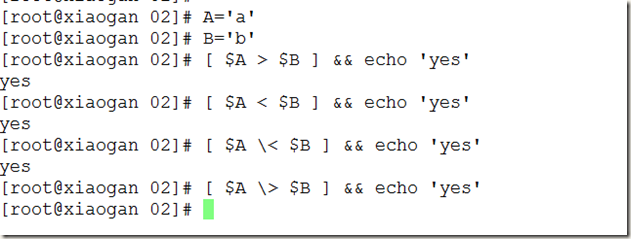
实战1:判断当前系统语言环境
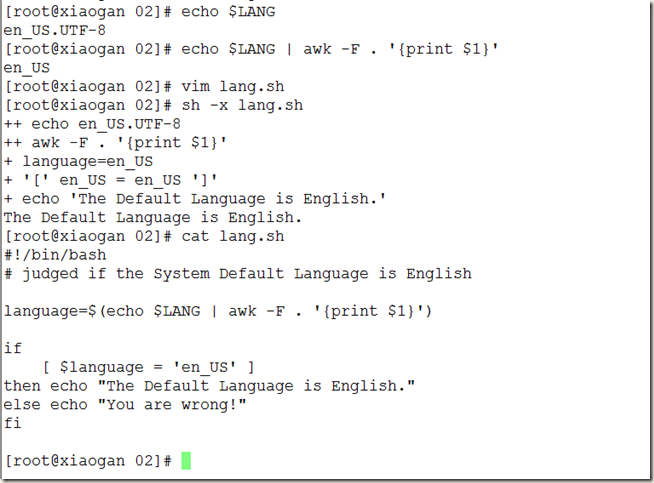
[root@xiaogan 02]# echo $LANG
en_US.UTF-8
[root@xiaogan 02]# echo $LANG | awk -F . '{print $1}'
en_US
[root@xiaogan 02]# vim lang.sh
[root@xiaogan 02]# sh -x lang.sh
++ echo en_US.UTF-8
++ awk -F . '{print $1}'
+ language=en_US
+ '[' en_US = en_US ']'
+ echo 'The Default Language is English.'
The Default Language is English.
[root@xiaogan 02]# cat lang.sh
#!/bin/bash
# judged if the System Default Language is English
language=$(echo $LANG | awk -F . '{print $1}')
if
[ $language = 'en_US' ]
then echo "The Default Language is English."
else echo "You are wrong!"
fi
[root@xiaogan 02]#
----------------------------------------------
if流程控制语句
if语句有三种使用方式:
格式如下:
单分支:
if 条件判断语句
then 执行语句
fi
双分支:
if 条件判断语句
then 执行语句
else 执行语句
fi
多分支:
if 条件判断语句
then 执行语句
else 执行语句
fi
##################################
实战1:if单分支--->应用
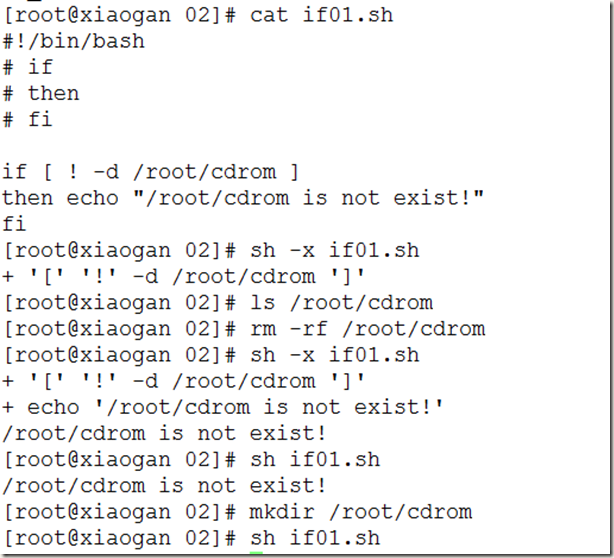
源码如下:
#!/bin/bash
# if
# then
# fi
if [ ! -d /root/cdrom ]
then echo "/root/cdrom is not exist!"
fi
##################################
实战2:if双分支应用--->pinghost.sh
ping -c 3 -i 0.2 -w 3 192.168.0.1
-c 发送数据包个数
-i 数据包每次发送间隔时间,默认单位:秒(s)
-w 等待时间,超过返回失败

源码如下:
#!/bin/bash
# ping a given host and print the host status
ping -c 3 -i 0.2 -w 3 $1 >>/dev/null #-c count -i -w wait
if [ $? -eq 0 ]
then echo "the host $1 is up."
else echo "the host $1 is down."
fi
##################################
实战3:if多分支应用--->判断数值区间 num_where.sh
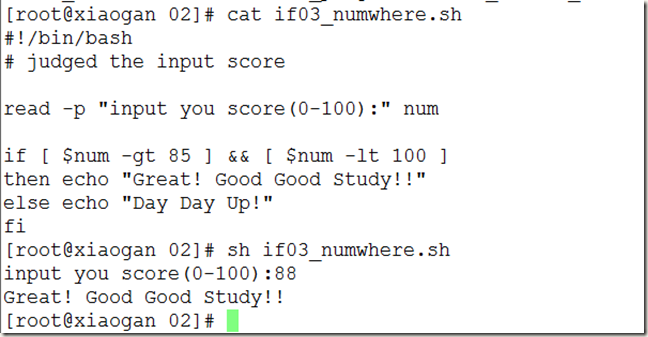
源码如下:
#!/bin/bash
# judged the input score
read -p "input you score(0-100):" num
if [ $num -gt 85 ] && [ $num -lt 100 ]
then echo "Great! Good Good Study!!"
else echo "Day Day Up!"
fi
##################################
实战4:if嵌套使用
编写脚本,监控服务运行状态,
启动失败后,保存日志,并重启服务,
再次失败,提示重启主机
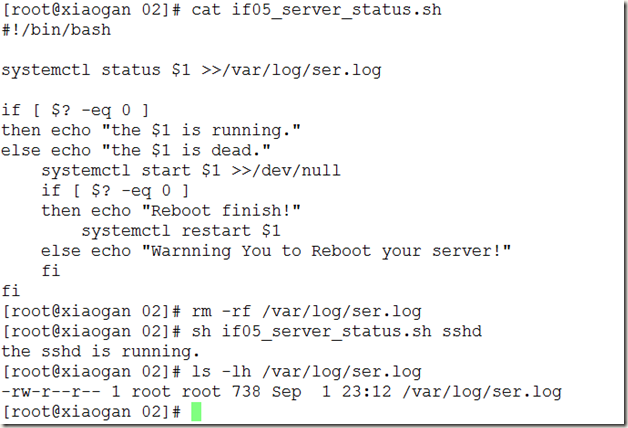
源码如下:
#!/bin/bash
systemctl status $1 >>/var/log/ser.log
if [ $? -eq 0 ]
then echo "the $1 is running."
else echo "the $1 is dead."
systemctl start $1 >>/dev/null
if [ $? -eq 0 ]
then echo "Reboot finish!"
systemctl restart $1
else echo "Warnning You to Reboot your server!"
fi
fi
##################################
实战5:查询内核版本,并输出信息
源码如下;
#!/bin/bash
# search the major version of System, and print info.
prime=$(uname -r | awk -F . '{ print $1}')
if [ $prime -gt 2 ]
then echo "The major version of System is $prime."
elif [ $prime -lt 1 ]
then echo "The System is too low."
else echo "Failed!"
fi
----------------------------------------------
for循环控制语句
用法:
for 变量名 in 变量遍历列表
do
循环语句
done #循环结束表示
##################################
实战:用户管理(批量添加用户)
方法一:
运行环境:
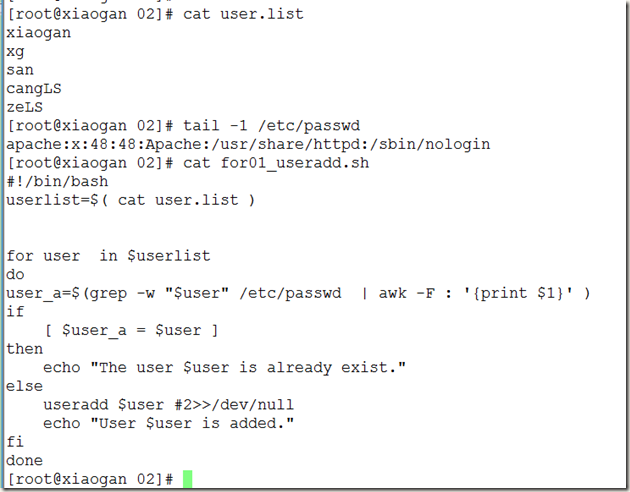
输出结果:
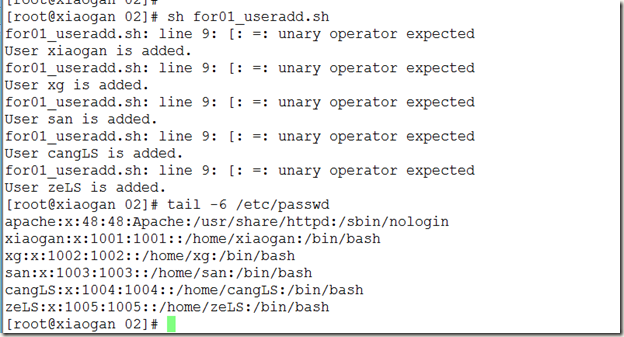
批量删除用户:
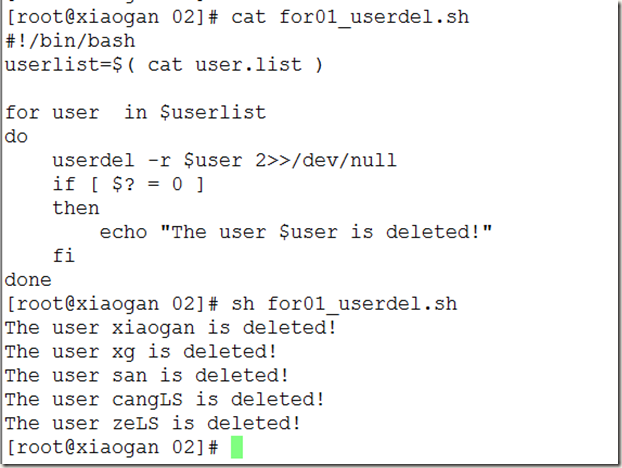
方法一优化:
我们发现,在用方法一批量添加用户是,当用户不存在时,会有报错信息。查看运行过程如下:
sh –x for01_useradd.sh
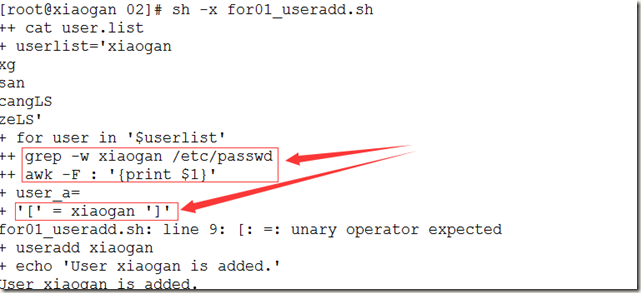
在进入循环后,我们会首先查找/etc/passwd下,是否已存在用户$user,
但是,在运行过程中,我们发现,当这个用户不存在时user_a数值为空,判断条件就会少了一个比较值,而造成判断条件变为:[ = xiaogan ],这是系统就会报错!
为了避免系统报错,我们可使用-z 或 -n选项来判断user_a变量是否为空。
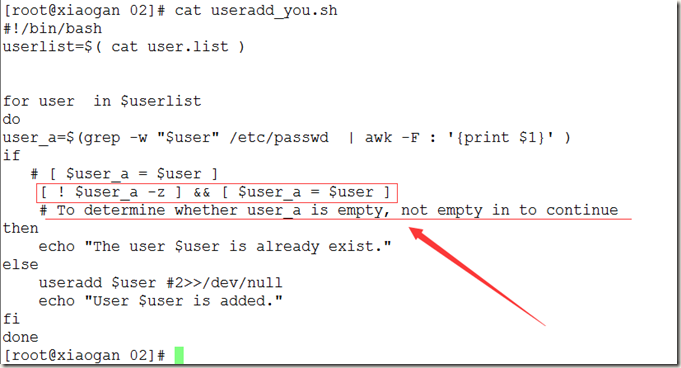
执行结果如下:
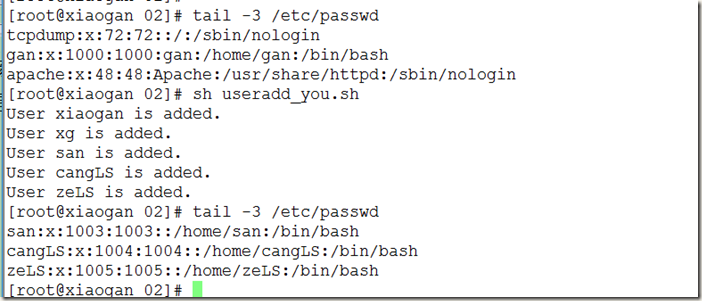
方法二:我们也可以采取另外一种方法,来批量添加用户
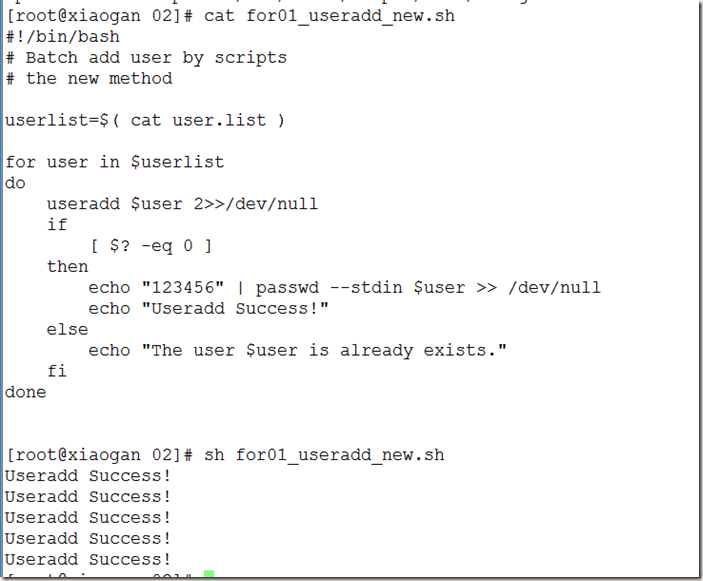
各方法源码如下:
方法一:
#useradd.sh
#!/bin/bash
userlist=$( cat user.list )
for user in $userlist
do
user_a=$(grep -w "$user" /etc/passwd | awk -F : '{print $1}' )
if
[ $user_a = $user ]
then
echo "The user $user is already exist."
else
useradd $user #2>>/dev/null
echo "User $user is added."
fi
done
###########
#userdel.sh
#!/bin/bash
userlist=$( cat user.list )
for user in $userlist
do
userdel -r $user 2>>/dev/null
if [ $? = 0 ]
then
echo "The user $user is deleted!"
fi
done
优化:
#useradd.sh
#!/bin/bash
userlist=$( cat user.list )
for user in $userlist
do
user_a=$(grep -w "$user" /etc/passwd | awk -F : '{print $1}' )
if
# [ $user_a = $user ]
[ ! $user_a -z ] && [ $user_a = $user ]
# To determine whether user_a is empty, not empty in to continue
then
echo "The user $user is already exist."
else
useradd $user #2>>/dev/null
echo "User $user is added."
fi
done
方法二:
#new useradd.sh
#!/bin/bash
# Batch add user by scripts
# the new method
userlist=$( cat user.list )
for user in $userlist
do
useradd $user 2>>/dev/null
if
[ $? -eq 0 ]
then
echo "123456" | passwd --stdin $user >> /dev/null
echo "Useradd Success!"
else
echo "The user $user is already exists."
fi
done
##################################
实战:ping.sh #批量测试IP地址是否连通
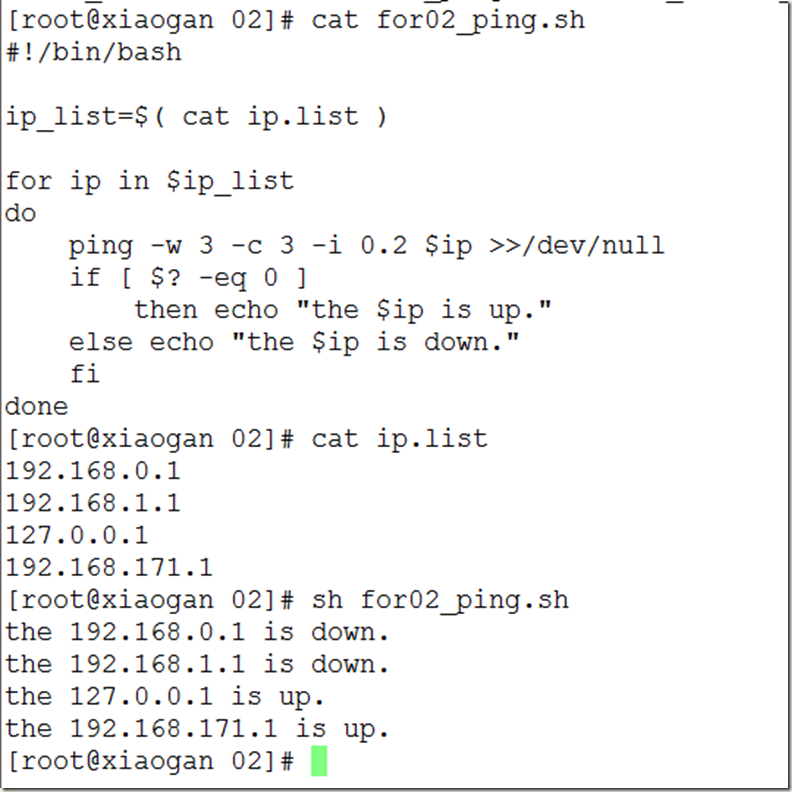
源码如下:
#!/bin/bash
ip_list=$( cat ip.list )
for ip in $ip_list
do
ping -w 3 -c 3 -i 0.2 $ip >>/dev/null
if [ $? -eq 0 ]
then echo "the $ip is up."
else echo "the $ip is down."
fi
done
转载于:https://www.cnblogs.com/xiaogan/p/5831848.html
最后
以上就是高挑睫毛最近收集整理的关于1-23-shell脚本之-if流程控制语句和for循环语句的使用的全部内容,更多相关1-23-shell脚本之-if流程控制语句和for循环语句内容请搜索靠谱客的其他文章。








发表评论 取消回复